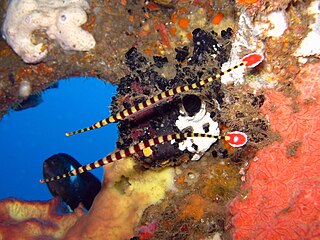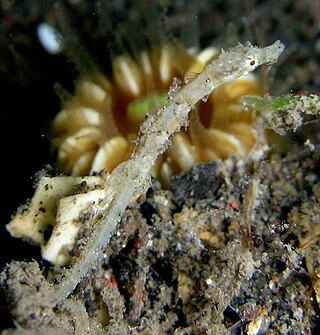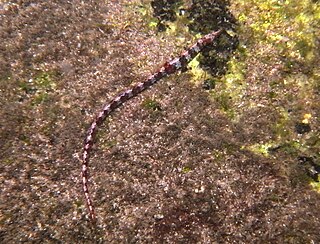
A seahorse is any of 46 species of small marine bony fish in the genus Hippocampus. "Hippocampus" comes from the Ancient Greek hippókampos (ἱππόκαμπος), itself from híppos (ἵππος) meaning "horse" and kámpos (κάμπος) meaning "sea monster" or "sea animal". Having a head and neck suggestive of a horse, seahorses also feature segmented bony armour, an upright posture and a curled prehensile tail. Along with the pipefishes and seadragons they form the family Syngnathidae.

The leafy seadragon or Glauert's seadragon, is a marine fish. It is the only member of the genus Phycodurus in the family Syngnathidae, which includes seadragons, pipefish, and seahorses.
Sea Dragon or seadragon may refer to:

The Syngnathidae is a family of fish which includes seahorses, pipefishes, and seadragons. The name is derived from Ancient Greek: σύν, meaning "together", and γνάθος, meaning "jaw". The fused jaw is one of the traits that the entire family have in common.

Male pregnancy is the incubation of one or more embryos or fetuses by organisms of the male sex in some species. Most species that reproduce by sexual reproduction are heterogamous—females producing larger gametes (ova) and males producing smaller gametes (sperm). In nearly all animal species, offspring are carried by the female until birth, but in fish of the family Syngnathidae, males perform that function.

Pipefishes or pipe-fishes (Syngnathinae) are a subfamily of small fishes, which, together with the seahorses and seadragons, form the family Syngnathidae.

Sea Life Melbourne Aquarium is a Southern Ocean and Antarctic aquarium in central Melbourne, Australia. It is located on the banks of the Yarra River beside and under the Flinders Street Viaduct and the King Street Bridge. The attraction is a Sea Life Centre owned by Merlin Entertainments.

Paracanthurus hepatus is a species of Indo-Pacific surgeonfish. A popular fish in marine aquaria, it is the only member of the genus Paracanthurus. A number of common names are attributed to the species, including regal tang, palette surgeonfish, blue tang, royal blue tang, hippo tang, blue hippo tang, flagtail surgeonfish, Pacific regal blue tang, and blue surgeonfish.

The Shanghai Ocean Aquarium is a public aquarium located in Shanghai, China.

The banded pipefish or ringed pipefish is a species of fish in the Syngnathidae family.

Amanda Vincent is a Canadian marine biologist and conservationist, one of the world's leading experts on seahorses and their relatives. She currently holds the chair of the IUCN SSC Seahorse, Pipefish and Seadragon Specialist Group and is the marine representative on the IUCN's International Red List Committee as well as being the chair of its Marine Conservation Committee. She previously held the Canada Research Chair in Marine Conservation at the UBC Institute for the Oceans and Fisheries at the University of British Columbia (UBC), Canada from 2002 to 2012. Vincent co-founded and directs Project Seahorse, an interdisciplinary and international organization committed to conservation and sustainable use of the world's coastal marine ecosystems. In 2020 she became the first marine conservationist to win the world's leading prize for animal conservation, the Indianapolis Prize.

Pregnancy has been traditionally defined as the period of time eggs are incubated in the body after the egg-sperm union. Although the term often refers to placental mammals, it has also been used in the titles of many international, peer-reviewed, scientific articles on fish, e.g. Consistent with this definition, there are several modes of reproduction in fish, providing different amounts of parental care. In ovoviviparity, there is internal fertilization and the young are born live but there is no placental connection or significant trophic (feeding) interaction; the mother's body maintains gas exchange but the unborn young are nourished by egg yolk. There are two types of viviparity in fish. In histotrophic viviparity, the zygotes develop in the female's oviducts, but she provides no direct nutrition; the embryos survive by eating her eggs or their unborn siblings. In hemotrophic viviparity, the zygotes are retained within the female and are provided with nutrients by her, often through some form of placenta.
The ruby seadragon is a marine fish in the family Syngnathidae, which also includes seahorses. It inhabits the coast of Western Australia. The species was first described in 2015, making it only the third known species of seadragon, and the first to be discovered in 150 years. A specimen found on shore in 2007 was 23.5 cm (9.3 in) long.

Phyllopteryx is a genus of small fishes, commonly called seadragons, in the family Syngnathidae that are found along the western and southern coasts of Australia. Since the 19th century, the weedy or common seadragon was the only known species, until the description of the ruby seadragon in 2015. They are closely related to other members of the Syngnathidae such as the leafy seadragon, pipefish and seahorses, which all exhibit male pregnancy.

The Great Southern Reef is a system of interconnected reefs that spans the southern coast of continental Australia and Tasmania and extends as far north as Brisbane to the east and Kalbarri to the west. It covers 71,000 km2 (27,000 sq mi) of ocean and straddles five states, running along the coast for 8,000 km (5,000 mi).

Acentronura breviperula, also known as the shortpouch pygmy pipehorse, dwarf pipehorse and northern little pipehorse, is a species of pygmy pipehorse, a member of the family Syngnathidae, the seahorses and pipefishes. It occurs in the Indo-Pacific region from the eastern Andaman Sea, through the Malay Archipelago to the Western Pacific as far east as New Guinea and the northern Great Barrier Reef.

Lissocampus runa, also known as the javelin pipefish is a species of marine fish belonging to the family Syngnathidae. This species can be found in algae beds, rocky reefs, tidepools, and estuaries along the coast of southern Australia from Broken Head Nature Reserve in New South Wales to Rottnest Island, Western Australia. Their diet is thought to consist of small crustaceans such as copepods. Reproduction occurs through ovoviviparity in which the males brood eggs before giving live birth.
Nannocampus pictus, also known as the reef pipefish, is a species of marine fish belonging to the family Syngnathidae. They can be found inhabiting reefs and seagrass beds of the western Indian Ocean and the eastern coast of Australia including the Great Barrier Reef. Members of this species can grow to lengths of 10 cm and their diet likely consists of small crustaceans such as copepods. Reproduction occurs through ovoviviparity in which the males brood eggs before giving live birth.
Nannocampus subosseus, also known as the bony-headed pipefish, is a species of marine fish belonging to the family Syngnathidae. They can be found inhabiting reefs and tide pools only in the region of Shark Bay to Esperance, Western Australia. Members of this species can grow to lengths of 12 cm and their diet likely consists of small crustaceans such as copepods. Reproduction occurs through ovoviviparity in which the males brood eggs before giving live birth.
Leafy seadragons are widely recognized for their strikingly derived characters, including leaf-like appendages, extreme spinal curvature, elongated craniofacial bones, and large body size. These make them phenotypic outliers in the teleost fish clade . Up until recently, the genome of leafy seadragons was unknown; but in 2022, their genome was fully annotated, along with weedy seadragons. Several significant features have been found in the leafy seadragon and weedy seadragon genomes, including divergent noncoding regions near a developmental gene responsible for integumentary growth; high genome wide repetitive DNA density; and recent transposable element expansions. Genetic diversity in leafy seadragons and weedy seadragons is relatively low as they have low-dispersal life history. Most recently, another species of seadragon was discovered and genetically sequenced: the ruby seadragon, which differs genetically and phenotypically from the two other seadragon species.



















